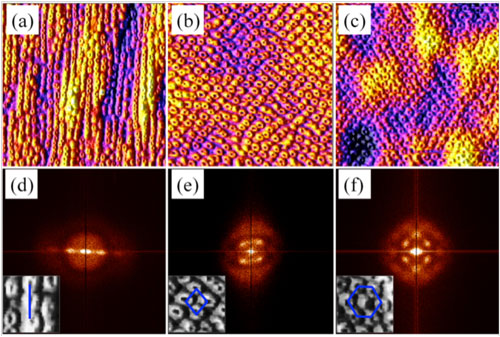| Posted: Jun 21, 2012 | |
Laterally aligned quantum rings |
|
| (Nanowerk Spotlight) Quantum rings show unique electronic, magnetic and optical properties. These unique properties make them attractive for various applications such as magnetic memory and systems for future quantum computers. To be used in practical applications, however,the quantum rings need to be fabricated in a controlled fashion. So far, the fabrication of laterally ordered quantum rings has not been reported. | |
| Now, though, researchers at the University of Electronic Science and Technology in China and the University of Arkansas Fayetteville have demonstrated a fabrication method to obtain large scale ordered quantum rings in a recent online issue of Applied Physics Letters ("Laterally aligned quantum rings: From one-dimensional chains to two-dimensional arrays"). | |
| The research team, led by Professors Zhiming Wang and Gregory Salamo have developed a series of growth procedures for engineering semiconductor materials at the nanoscale, such as droplet epitaxial growth of quantum dot molecules and controlled growth of quantum dots on pre-patterned substrate. | |
| "The quantum rings can be simply created by partially capping quantum dots," Wang tells Nanowerk. "The key to fabricating ordered quantum rings is to create ordered quantum dots." | |
 |
|
| AFM images of laterally ordered quantum rings fabricated on different substrates: (a) GaAs (100), (b) (311)B, and (c) (511)B surfaces. The fast Fourier transform patters taken from the corresponding AFM images are shown in the second row: (d) GaAs (100), (e) (311)B, and (f) (511)B surfaces. The insets in (d), (e) and (f) are the magnified AFM images of quantum rings ordered in different lattice structures. (Source: Wang and Salamo reserach groups at University of Electronic Science and Technology and University of Arkansas Fayetteville) | |
| In this recent work, the scientists have demonstrated ordered quantum rings by a simple growth technique which combines the fabrication of ordered quantum dots through strain engineering and dot-to-ring transformation through partial capping. | |
| "These ordered quantum rings are grown over stacked multiple quantum dots, which creates a periodic strain field during epitaxial growth and forces the subsequent nanostructures form in an ordered array," explains Wang. | |
| In the new findings, the researchers also grow quantum rings with different ordering patterns controlled by different oriented surfaces. | |
| "One of the more exciting observation in this work is the fabrication of ordered quantum rings in different patterns" says Jiang Wu, the paper's first author. "Using this method, we can now control the formation of ordered quantum rings with different patters at a large scale." | |
| The researchers point out that they can change the lateral ordering patterns of quantum rings by using different Miller index surfaces. | |
| One-dimensional quantum ring chains have been fabricated on a GaAs(100) surface but two-dimensional ordered quantum ring arrays have been observed only on high-index surfaces such as GaAs(311) and GaAs(511). | |
| "By using the high index surfaces, we have now demonstrated quantum ring arrays with rhombic symmetry and hexagonal symmetry" says Wang. | |
| This method opens the opportunity for fabricating large-scale ordered quantum ring structures for other material systems, such as SiGe. These ordered quantum rings may be of interest for investigating possible collective effects in these arrays. | |
 By
Michael
Berger
– Michael is author of three books by the Royal Society of Chemistry:
Nano-Society: Pushing the Boundaries of Technology,
Nanotechnology: The Future is Tiny, and
Nanoengineering: The Skills and Tools Making Technology Invisible
Copyright ©
Nanowerk LLC
By
Michael
Berger
– Michael is author of three books by the Royal Society of Chemistry:
Nano-Society: Pushing the Boundaries of Technology,
Nanotechnology: The Future is Tiny, and
Nanoengineering: The Skills and Tools Making Technology Invisible
Copyright ©
Nanowerk LLC
|
|
|
Become a Spotlight guest author! Join our large and growing group of guest contributors. Have you just published a scientific paper or have other exciting developments to share with the nanotechnology community? Here is how to publish on nanowerk.com. |
|
